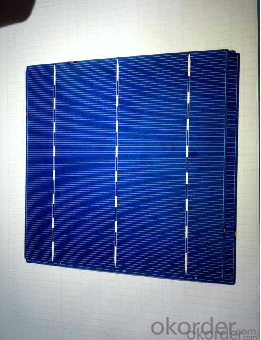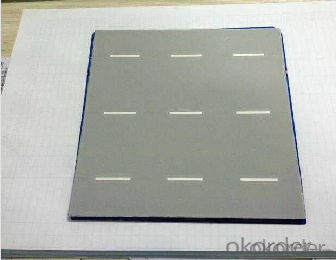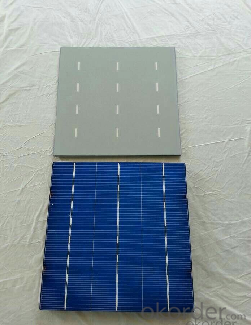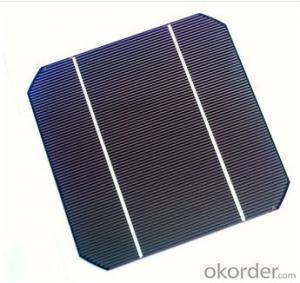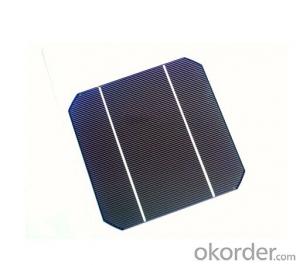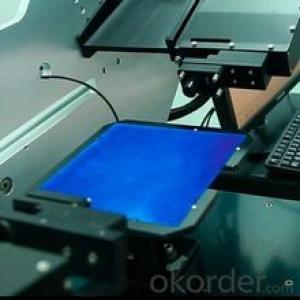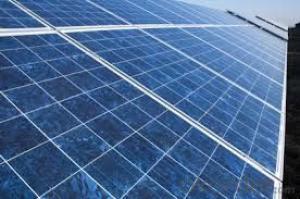Organic Photovoltaic Solar Cells - Poly A Grade CNBM Solar Cells with Different Efficiency
- Loading Port:
- Shanghai
- Payment Terms:
- TT OR LC
- Min Order Qty:
- 100 pc
- Supply Capability:
- 10000000 pc/month
OKorder Service Pledge
OKorder Financial Service
You Might Also Like
Product Description:
Solar cells are often electrically connected and encapsulated as a module. Photovoltaic modules often have a sheet of glass on the front (sun up) side, allowing light to pass while protecting the semiconductor wafers from abrasion and impact due to wind-driven debris, rain, hail, etc. Solar cells are also usually connected in series in modules, creating an additive voltage. Connecting cells in parallel will yield a higher current;our solar cells have passed IEC Certification. With high quality and stable quality. Our Cells can greatly improve the performance of Solar Modules
2.SPECIFICATION:
Efficiency (%) | Pmpp (W) | Umpp (V) | Impp (A) | Uoc (V) | Isc (A) | FF (%) |
18.35 | 4.384 | 0.526 | 8.333 | 0.63 | 8.877 | 78.39% |
18.20 | 4.349 | 0.526 | 8.263 | 0.63 | 8.789 | 78.54% |
18.05 | 4.313 | 0.525 | 8.216 | 0.63 | 8.741 | 78.32% |
17.90 | 4.277 | 0.524 | 8.161 | 0.629 | 8.713 | 78.04% |
17.75 | 4.241 | 0.523 | 8.116 | 0.629 | 8.678 | 77.70% |
17.60 | 4.206 | 0.521 | 8.073 | 0.628 | 8.657 | 77.36% |
17.45 | 4.170 | 0.519 | 8.039 | 0.628 | 8.633 | 76.92% |
17.30 | 4.134 | 0.517 | 8.004 | 0.626 | 8.622 | 76.59% |
17.15 | 4.098 | 0.516 | 7.938 | 0.625 | 8.537 | 76.80% |
17.00 | 4.062 | 0.512 | 7.933 | 0.625 | 8.531 | 76.18% |
16.75 | 4.002 | 0.511 | 7.828 | 0.625 | 8.499 | 75.34% |
16.50 | 3.943 | 0.510 | 7.731 | 0.625 | 8.484 | 74.36% |
3.IMAGES:
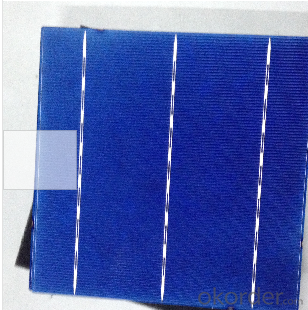
4.Packaging & Delivery of Mono Solar Cells
Carton Box Package and Deliver by air. It should be noticed that it should be avoid of water, sunshine and moist.
5.FAQ:
WHAT'S YOUR ADVANTAGE OF YOUR PRODUCTS?
1. High efficiency and High power.
2. Long-term electrical stability.
3. Lowest price and Fastest delivery.
4. Good quality and best service.
5. Bulk supply
6. Trusted Warranty
7. Big Sale
8. More than 25 years on the lifetime.
- Q: What is the typical size and weight of a solar cell?
- The typical size of a solar cell can vary depending on its application, but a standard residential solar panel is usually around 65 inches by 39 inches, with a thickness of about 1.5 inches. In terms of weight, a typical solar cell can weigh anywhere from 40 to 50 pounds.
- Q: Can solar cells be used in remote sensing devices?
- Yes, solar cells can be used in remote sensing devices. Solar cells convert sunlight into electricity, which can power various sensors and data collection devices used in remote sensing applications. The use of solar cells ensures that these devices can operate independently and sustainably in remote locations without the need for external power sources.
- Q: Silicon solar cell power generation principle
- When the junction of two different materials formed by the light irradiation, the process of generating electromotive force.The process of the first material absorbs the energy of the photon, resulting in equal number of positive and negative charge, then these charges were migrated to both sides of the knot, The formation of even electricity layer. Although the effect is not generated instantaneous, but the response time is quite short.
- Q: What is the role of bypass diodes in solar cell systems?
- The role of bypass diodes in solar cell systems is to minimize the impact of shading or partial module failure. They allow current to bypass the shaded or malfunctioning cells, preventing them from reducing the overall performance of the system.
- Q: What is the typical lifespan of a solar cell?
- The typical lifespan of a solar cell is around 25 to 30 years.
- Q: Can solar cells be used for powering communication towers?
- Yes, solar cells can be used for powering communication towers. Solar panels or cells can generate electricity from sunlight, which can be converted and used to power various electronic devices and equipment, including communication towers. This renewable energy source is increasingly being adopted to reduce reliance on traditional power grids and decrease carbon emissions.
- Q: Do solar cells work at night or in low light conditions?
- Solar cells do not work at night as they require sunlight to generate electricity. In low light conditions, their efficiency decreases significantly, but they can still produce some electricity, although at a much lower rate.
- Q: How much electricity can a solar cell generate?
- The amount of electricity that a solar cell can generate depends on various factors such as the size of the cell, the efficiency of the cell, the intensity of sunlight, and the duration of exposure. Generally, a solar cell can produce anywhere from a few watts to several hundred watts of electricity.
- Q: Why should the solar cells be laserized?
- While the P2, P3 level with green nano-laser is the most ideal. In the actual experiment process using green picosecond laser technology the best, but taking into account the cost of equipment into the point of view, green nanosecond most ideal
- Q: Can solar cells be used in electric grid stabilization?
- Yes, solar cells can be used in electric grid stabilization. Solar power can be integrated into the electric grid through the use of grid-tied solar systems, which allow excess energy generated by solar cells to be fed back into the grid. This helps stabilize the grid by reducing strain during peak demand periods and providing a cleaner and more sustainable source of electricity. Additionally, solar energy can be combined with energy storage systems, such as batteries, to provide backup power and further enhance grid stability.
Send your message to us
Organic Photovoltaic Solar Cells - Poly A Grade CNBM Solar Cells with Different Efficiency
- Loading Port:
- Shanghai
- Payment Terms:
- TT OR LC
- Min Order Qty:
- 100 pc
- Supply Capability:
- 10000000 pc/month
OKorder Service Pledge
OKorder Financial Service
Similar products
Hot products
Hot Searches
Related keywords



